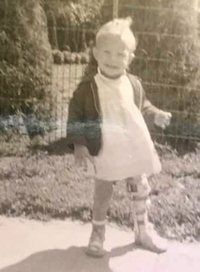Though polio, or poliomyelitis, is a rare condition today, many who have had the diagnosis are still facing continued aftereffects years later. With an inspiring journey of overcoming continued challenges while maintaining faith, Mary Jo Halverson takes me through her history with this condition.
Polio, a virus that can affect the spinal cord, causing muscle weakness or paralysis, is now prevented through a vaccine given during childhood. At the time the polio vaccine came out, Halverson, around the age of one, was too young to receive it and ultimately became infected.
Taken to the doctor because of a fever, Halverson’s legs gave out when her mom tried standing her up. Her mom knew instantly that her little girl was infected by the virus. She was the only one in her family affected; her three older sisters were old enough to get the vaccine.
Halverson soon began to experience breathing difficulties and was put in an iron lung for 6 months, a device used to mimic the way a body’s chest muscles and diaphragm move air in and out of the lungs. During this time, her mother could not hold her baby girl but instead could only look at her through the glass.
Because the polio most affected Mary Jo’s left leg, she needed several constructive surgeries throughout her childhood. These began around age two and she continued to have about eight more surgeries in her youth.
Fortunately, the Shriners society helped make these surgeries a possibility; her mom, a single parent, could not afford such high medical costs. She explains her gratefulness to the organization for covering the cost of all but one of the surgeries.
She tells me about being featured in an old Yankton Press & Dakotan issue when she was five years old and remembers it clearly. A picture of her standing aside Yankton Mayor Vanderhule and a representative of the March of Dimes was displayed on the front page. The caption referred to her as “Yankton County’s Polio Girl” and the special event was Mayor Vanderhule issuing a proclamation designating the month of January as New March of Dimes Month in Yankton. It was an exciting experience for her, as it would be for any child. She remembers her anticpation picking out a new dress for the occasion. She thinks back, “There was a bunch of people there and I walked out on the stage and said, ‘Please give to the March of Dimes’ and everyone clapped.”
She laughs, “I felt like I was a movie star!”
As she got older, she was eventually fitted with a full iron leg brace on her left leg and a thick riser in her shoe to balance out the 3-inch height difference among her legs. When she started elementary school, she didn’t realize she was any different from her peers until the name calling started. She remembers how mean the kids could be and how she endured several years of it. She laughs as she tells me how protective her older sisters were of their baby sister, and they always watched over her. Though she can’t recall many classmates affected by Polio, she does remember another boy with it and had heard the two were even in the hospital at the same time. She felt fortunate by comparison; Polio had affected his entire body.
Fast forward to her 20’s and she began to be diagnosed with other physical conditions, starting with bursitis and fibromyalgia. During her 30’s, the single mom of five worked at Hatch Furniture in Yankton.
She slowly noticed that she began to make mistakes often, ones that were unusual for her. She started to get sick often. “Really sick,” she explains, “like a sick that I couldn’t fight.” The symptoms prompted her to visit Sister Kenny Institute in Minneapolis, MN, where she learned about post-polio syndrome, a condition that can affect polio survivors’ years after their diagnosis, causing fatigue, gradual muscle weakening and pain. Her doctor pointed out that she couldn’t continue to live life at that pace, working full time and taking care of her five boys; it was jeopardizing her health.
After qualifying for Social Security income, she stopped working to focus on getting in better health. As she progressed physically, she began to struggle psychologically. Her self-esteem and self-worth, already fragile, sank even lower, and she turned to alcoholism. With time, she sought the treatment of medical professionals, counselors, and family to help get her life in balance and the support worked. She recently celebrated 27 years of sobriety with her five sons and good friend Jeff Comstock helping serve as a strong support system.
Looking back, she sees that she should have taken better care of herself. “You push to prove to that you can do what everybody else can do, and that in turn is what tears your body down. All my life, I pushed and pushed and pushed, and now it’s pushing me back.”
Her faith continues to be strong as her body gradually becomes weaker. “If it wasn’t for God, I don’t know where I would be,” she humbly confesses. Considering the adversity she’s encountered in life, it’s remarkable how she’s pulled through all of life’s curveballs with such gratitude and positivity. Her children kept her going through the hardships. “They’re awesome. They are the most loving boys.” She sums up her journey in one short sentence. “It’s been a roller coaster to say the least,” she admits.
Halverson is now emotionally healthy but her physical health has continued to decline over the years. Though she now spends some time working and volunteering, she still struggles daily with unbearable pain. She has continued to be diagnosed with other conditions which now include COPD and believes much of it was because of her weakened immune system and pushing her body to extremes. She laughs, “I don’t know how I’m still alive. God just isn’t finished with me yet.



